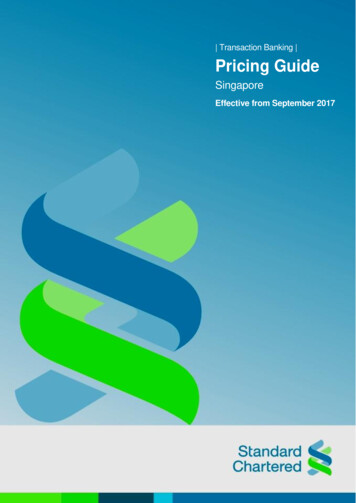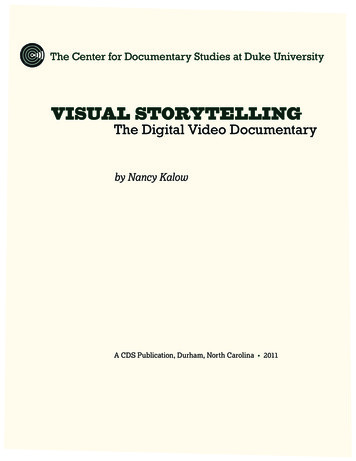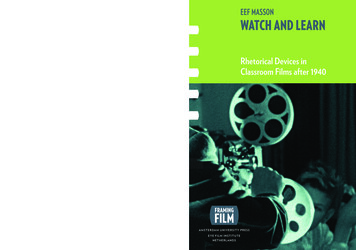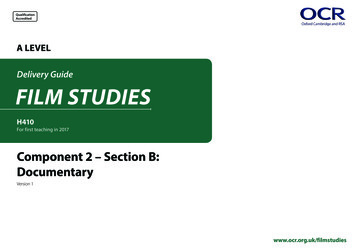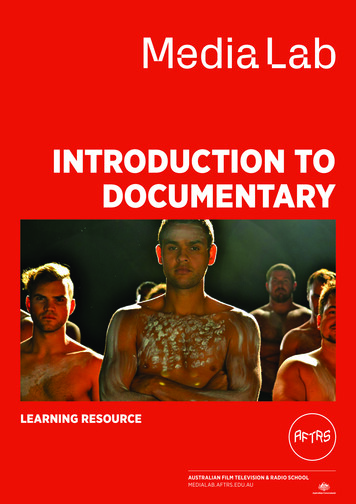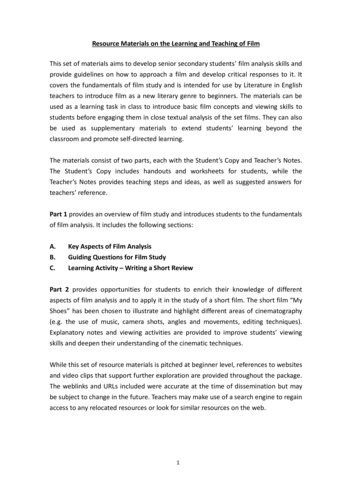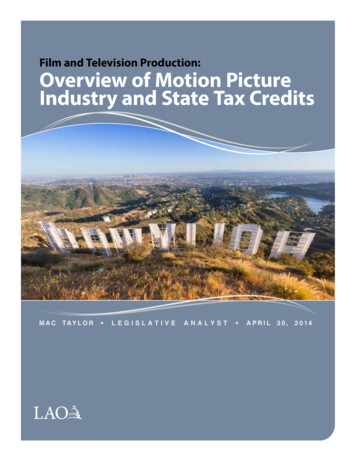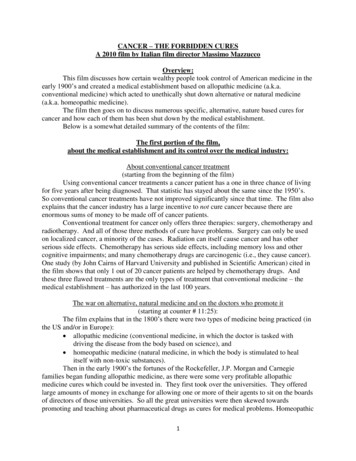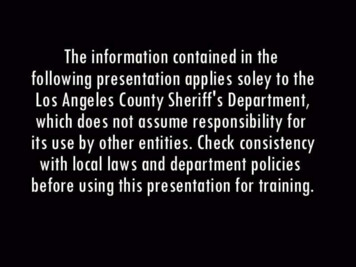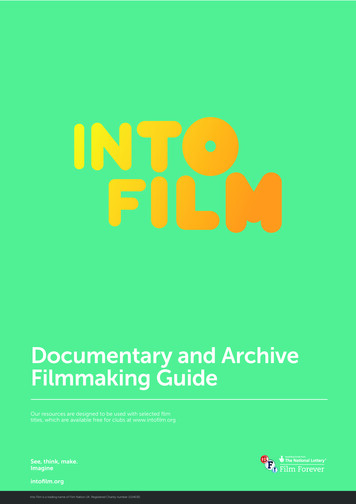
Transcription
Documentary and ArchiveFilmmaking GuideOur resources are designed to be used with selected filmtitles, which are available free for clubs at www.intofilm.orgSee, think, make.Imagineintofilm.orgInto Film is a trading name of Film Nation UK. Registered Charity number 1154030.
Our resources are designed to be used with selected film titles, which are available free for clubs at www.intofilm.orgActivity packDocumentary and Archive Filmmaking GuideContentsIntroductionCreating documentary filmsCreating films with archive footage2Warm up activities3Documentary styles and techniques4Planning your documentary5Creating films with archive footage6Compliance and staying safe7Film languageShots, angles, light and sound8Post-production11Sharing your film12AppendixContributor Release FormAdult Interviewee Release FormLocation Release FormLicence for Existing Material FormComposer AgreementIP Checklist14iiiiiiivvviintofilm.org2
Our resources are designed to be used with selected film titles, which are available free for clubs at www.intofilm.orgActivity packDocumentary and Archive Filmmaking GuideIntroductionThis resource has been designed by Into Film to supportteachers to make creative and engaging documentarieswith students and make the most of opportunities toaccess regional and national archive material to supportstorytelling through film.Creating documentary filmsMaking films at school does not have to be complicatedand expensive. In fact, you probably have the basicequipment in your school to get started. This includes acamera to record video, a microphone to record soundand editing software. It is possible to make a goodshort documentary with nothing more than a mobilephone, an enthusiastic interviewer and some interestingsubjects.There are lots of ways that you can make a creative andengaging documentary in the classroom such as:Ŕ Ŕ Ŕ a short observational documentary about a day inthe life of your school.a reconstruction of an historical event in your localcommunity.interview members of your local community aboutan event happening in your town.This guide will provide you with a range of practical tipson creating good documentaries in your classroom.Creating films with archive footageArchive footage (including newsreels, feature films,public information advertisements, amateur footage) isan excellent resource for making short films with youngpeople as it:Ŕ Ŕ Ŕ provides a unique window into national, regional andcommunity histories.allows them to make films about events in thepast without using costly and time-consumingreconstruction.can be an exciting way to engage them with localhistory and heritage – seeing places that theyrecognise in the past can really trigger young people’sinterest in finding out more about their community’sheritage.This guide will provide you with a range of useful tips foraccessing and using archive footage in your own films.intofilm.org3
Our resources are designed to be used with selected film titles, which are available free for clubs at www.intofilm.orgActivity packDocumentary and Archive Filmmaking GuideWarm up activitiesInterviewing peopleFreeze frameUse the BBC Bitesize film, How do we interviewpeople? www.bit.ly/bbcbitesizeinterviewpeopleŔ Ŕ Ŕ Ask students to identify three key points weshould consider when we interview someoneabout the past.Give small groups a tablet or flip camera. Eachstudent takes their turn to be the interviewerusing the three key points they have identified.Sound on/vision offŔ Pictures from the pastUse a selection of black and white photographs,preferably from 1935 onwardsIn groups of four, ask students to review one of thepictures and to answer the following questions:Ŕ When was the picture taken? How do youknow that?Ŕ What do we know about the people in thepicture?Ŕ What would life have been like at that time?Ŕ How did life then differ from life today?Pause a short sequence on each shot. Ask groupsto talk about what is in each shot and why it isthere. They could also discuss what kind of story itis, where they think it is set, and what they think willhappen next.Ŕ Choose an opening sequence with a goodsoundtrack and a variety of different sounds. Itcould have just diegetic (‘natural’/‘real’) sounds, orthere could be music as well.Play the sound without the picture. Ask groups tolist everything they hear, and what it makes themimagine about the place, the people, the time ofday/year, and the story.Framing with the cameraSet each group the task of shooting examples ofdifferent kinds of shots with no camera movements orzooms (e.g. one person shoots a long shot, the nextperson shoots a close-up, and so on), then screen anddiscuss what they have filmed.Learning about cutsŔ Ŕ Ŕ Play a short film sequence. Ask students toguess how many separate cuts there were in it.Play it again and ask students to clap on eachcut. Ask them to count the number of timesthey have clapped.Ask students to talk about why there are somany cuts.intofilm.org4
Our resources are designed to be used with selected film titles, which are available free for clubs at www.intofilm.orgActivity packDocumentary and Archive Filmmaking GuideDocumentary styles and techniquesThe main purpose of documentary filmmaking iscontained within the name: document. When makinga documentary you are trying to create a documentof an aspect of reality, focusing on a story, event orindividual.There are usually two approaches for creating adocumentary: to get involved, have a presenter andask questions; or observe, with no presenter andwatch things unfold.Both of these styles work well but it is up to youto decide which path you want to follow. With apresenter it can be easier to get the information youwant, but without one it is easy to get that feeling of‘fly on the wall’ filmmaking. When you are workingwith archive footage you may want to use a voiceoverthat explains where we are in history and what thesubject matter is.Although there are a number of different documentarystyles to choose from, your film will follow one of twodifferent approaches:1.2.Documentaries which follow an event or placeDocumentaries which tell a person’s storyThe best documentaries cover both of these aspectsat the same time. They both follow an event, and tellthe stories of the people who were involved. Usingarchive footage you can choose an individual’s storyor an event or situation from a specific time in history.intofilm.orgThere are a number of techniques that you can use tocapture your documentary, depending on the type of filmyou want to make:Ŕ Voiceover - commentary by the filmmaker or actor,spoken while the camera is filming, or added to thesoundtrack during the editing stageŔ Vox pops - people walking past in a public place areasked their opinion on a particular subjectŔ Interviews - allows people being filmed to speakdirectly about events, prompted by questions askedby the filmmaker /interviewer.Ŕ Re-enactment/Reconstruction - filmed artificialscenes of an event which has been reconstructed andacted out based on information of the eventŔ Archive footage - existing footage of somethingalready filmed from a long time ago that has beensaved. You can use this in your documentary to showhistorical eventsA good documentary will include more than one ofthese elements to help build the narrative structure. Forexample, you could record a voice over and play this oversome archive footage. You could also include interviewsand then a re-enactment of the event being discussed.5
Our resources are designed to be used with selected film titles, which are available free for clubs at www.intofilm.orgActivity packDocumentary and Archive Filmmaking GuidePlanning your documentaryThere are three key things you should consider whendeciding on the idea for your documentary:SubjectThe starting point will be to identify what your film isabout. Is there a place or an event in history that you wantto document? What is it about this that interests you?What happened and what do you want to say about it?Perhaps you have been inspired by a piece of archivefootage to find out more about a place or event.Whatever the subject, select something that interests youand your pupils.Research is an important part of the planning process.Find out as much as you can about the subject youhave selected. This will help you to build a picture of theperson or event and to identify the key questions thatyou want to answer throughout your documentary.CharactersOnce you have decided on the focus for yourdocumentary, you need to select your charactersor subjects. The subjects are the people in yourdocumentary that are either interviewed or filmed to helptell your story.StructureFor documentaries, you will need to write a treatment.A treatment is a short story narrative (usually one side ofA4) in the present tense that describes your film sequenceby sequence so the reader can actually visualise whatwill be seen and heard on the screen. Where possibleinclude information about your characters and try anduse their own words. Do include any conflict you imagine,emotions and how the character(s) may develop.If you are filming a re-enactment of an event for yourdocumentary, you should write a script. This shouldinclude dialogue, character action and location dividedinto scenes. This is where you describe on paper exactlywhat your characters will say.Storyboards help you plan on paper how your entire filmwill look and prepares you for your shooting days andthe final edit. Even if your drawing skills are not very good(stick people are fine) having a storyboard can help visuallyexplain your idea to your crew.If you have not made a documentary before, why not getyour inspiration from other documentaries. Watch a rangeof different documentaries to see what techniques andapproaches you like and use these.If your documentary focuses on an individual or a groupof people, you should consider what is so intriguingabout them to make you want to tell their story. Also,is their story interesting enough to hold the audience’sattention?If your documentary focuses on an event you shoulduse different subjects to talk about the event to addsome context to your story. This could include someonethat was present at the event or it could include a localhistorian with an in-depth knowledge of the event.intofilm.org6
Our resources are designed to be used with selected film titles, which are available free for clubs at www.intofilm.orgActivity packDocumentary and Archive Filmmaking GuideCreating films with archive footageThere are a number of ways that you can usearchive film footage to enhance your documentary:Top tips on using archive footageŔ Ŕ Ŕ Ŕ Ŕ Ŕ Archive film can be used in documentariesto look at changes and similarities betweenpast and present. For example, a documentaryexploring the changing landscape of a city overtimeYoung people can use the archive materialliterally, as visual evidence in a documentaryabout a specific historical subjectArchive material can also be used morelaterally, ignoring the original subject matterand historical context of the footage andrepurposing it as a source of imagesIt can provide inspiration when thinkingabout ideas development and approaches tostorytellingWorking with archive footage and simple greenscreen technology offers a range of creativepossibilities including transporting the actors/subjects back in timeŔ Ŕ Ŕ Ŕ Ŕ ArchiveŔ Below is a link to a regional map of archive footageonline. This footage can be used. You will needto check if you can include the footage in yourdocumentary. Permission has to be sought if youwant to use it to include in your documentary.England, Scotland and Waleswww.bit.ly/ukarchivesmapŔ Ŕ Engage young people with the archive materialfrom the beginning of the project to inspire theirfilm ideas.When planning a viewing session remember thatmany of the young people may have never seenarchive film footage.Don’t forget to explain what an ‘archive’ is, as theyoung people might not understand what it is.You might also find it useful to show examplesof contemporary films that incorporatearchive footage, to encourage young peopleto think about how it can be combined withcontemporary footage in a meaningful anddynamic way.Although you will have already done some preselection of the archive footage involve youngpeople in making decisions about which specificarchive clips they are going to work with. Thiscan then be included in their storyboards orshooting scripts.If the young people are making a film about theirlocal area, think about including some matchshots (the same location seen in the archivefootage shot from the same place).Green screen can be used to creative effect,using the archive footage as background for liveaction.Think about using music to help create theatmosphere of the era featured in the archivefootage.Avoid having long sections of archive footageaccompanied by voiceover; break it up withcontemporary footage.There is a digital archive hosting film clips thatschools in Northern Ireland can access with a login:www.rewardinglearning.org.uk/creative learningNorthern Ireland Screen Digtial Film Archivewww.bit.ly/niscreenarchiveThe organisations below also have online archive footage:BFI (British Film Institute) www.bfi.org.uk/britainonfilmBritish CouncilImperial War Museumintofilm.org7
Our resources are designed to be used with selected film titles, which are available free for clubs at www.intofilm.orgActivity packDocumentary and Archive Filmmaking GuideCompliance and staying safeComplianceCheck the factsCompliance in film means making sure that the filmyou make complies with the law. In other wordsmaking sure it does not break any of the rules and cantherefore be shown to a wider audience. Make sureyou familiarise yourself with the guidelines below. Youmay make a great film, but if it does not follow thestandard broadcast guidelines, you will not be ableto have your film shown on the internet or be able toenter competitions and film festivals.Factual projects must not mislead the audience andmisrepresent facts, individuals or organisations. Make sureyou do your research well and that your documentary iswell informed. Be balanced by making sure you get acrossall points of view.Obtain permissionMake sure anyone taking part in your project hasagreed to do so in writing before any recording takesplace. They need to sign a document called a releaseform. A Contributor Release Form can be found inAppendix i. An Adult Interviewee Release Form canbe found in Appendix ii.If anyone involved is under 18 years old makesure you have written permission from a parent orguardian before any recording takes place.You need written permission to record anythingin buildings, in public places, in institutions, inorganisations, in agencies or any private propertyunless it is only in the background. This form is calleda location release form and needs to be signed by theowner or manager of the property or land. A LocationRelease Form can be found in Appendix iii.Make sure any material you use (whether visual oraudio) is original to your project. You should onlyuse photos, film clips, audio clips or pre-recordedmusic if you have written permission. For example,you cannot use commercial music such as the latestKaty Perry song without written permission from therecord company and songwriter. Also, you cannot useimages from an online image library that may own thephotos or clips of video that you want to use withouttheir permission. It is better to use original materialin most cases, which will encourage students to bemore creative.Keep it safeHealth and safety is your number one concern whilefilming, and far more important than getting the shot.Think carefully about dangers in the locations you intendto film in. Even a street can be full of hazards. Assess everysituation carefully and use your common sense. Do nottake any risks and do not become a risk to others.Respect for Intellectual PropertyIntellectual Property or IP is a term that refers to an originalcreation, design or idea that belongs to a person or a groupof people. This includes films, songs, books and designs.The owner of a particular piece of IP has control over howtheir work is used and can expect to be rewarded for itsuse. This means that anyone who has a new creative orinnovative idea has the right to benefit from it.To learn more about the importance of IP watch thisstudent made film Vin Diesel’s Socks (2013) on IntoFilm's Clubs YouTube channel, commissioned inpartnership with the Industry Trust.www.bit.ly/vindieselssocksand visit www.getitrightfromagenuinesite.orgAn IP Checklist can be found in Appendix vi.intofilm.org8
Our resources are designed to be used with selected film titles, which are available free for clubs at www.intofilm.orgActivity packDocumentary and Archive Filmmaking GuideFilm languageYour students need to learn the ‘language’ of film: howthey can use pictures, sound and editing to tell stories.Even quite young children can think about things likeshot size, where to put the camera, and basic soundwhen they learn the language of film.A mid shot shows the top half of the body. You can seethe face and what the person is doing.The cameraShot sizeYou can use different sized shots to show differentthings in your film.When they get started, young filmmakers sometimestry to shoot everything with mid shots or long shots,because they’re easy to film. If they learn to use avariety of different shots, their films will have a lot moreimpact tell a better story.A long shot shows someone from head to foot. Youcan see the person in the setting. With an extremelong shot or establishing shot you are too far away torecognise people. You can use it at the start of the filmto show the setting.Here are the main shot sizes (with younger children,you could just concentrate on three of these: long shot,mid shot and close-up.An extreme close-up shows just a small part of aperson or thing. Use it to show an important detailA close-up shows part of the subject - their face, ormaybe their head and shoulders. It lets you imaginewhat they are feeling.intofilm.org9
Our resources are designed to be used with selected film titles, which are available free for clubs at www.intofilm.orgActivity pack Documentary and Archive Filmmaking GuideCamera angleCamera movementsPutting the camera in different places is important totell the story and make it interesting. Instead of justshooting everything at eye level, the camera can goabove, below or behind the subject.Moving the camera can show more about the location andstory. Movements should be steady and should normally goin just one direction, not back and forth. Using a tripod is thebest way to achieve a steady shot but if you do not have atripod, rest against a wall or sit on a chair to steady yourself.If you want to make a person or thing seem importantor scary, use a low angle shot that points the cameraup at them.Steady, slow tracking shots are a great way to show a spaceor what a character is seeing. Put the camera on somethinglike a wheelchair or skateboard. It can go forwards (track in),backwards (track out), or sideways (crab).A high angle shot looks down and make people lookweaker or frightened.A tilt shot turns the camera upwards or downwards. Theclassic example is the shot that starts with someone’s feetand tilts up to show how big or scary they are.With a pan shot, the camera turns left or right to scan ascene or follow a movement.intofilm.org10
Our resources are designed to be used with selected film titles, which are available free for clubs at www.intofilm.orgActivity packDocumentary and Archive Filmmaking GuideUsing the lensSoundThe purpose of lighting in a film is to set the mood,create an atmosphere and to illuminate your actorsso the camera can capture good quality visuals.Sound is easily the most overlooked aspect offilmmaking. It is just as important as the visuals youcapture on film. Audiences can be very tolerant ofshaky camerawork or bad lighting but not so forgivingif the sound is bad and they cannot follow the story.Slightly over or under exposed shots can be correctedin the edit but very little in fact can be corrected insound that is not clean.Your film project probably does not needprofessional film lighting. Natural light can be usedvery effectively and turning on main lights andeven side lamps when filming indoors can be veryvisually interesting. For example, a torch positionedwell to the side of the subject can provide low-keylighting for a thriller scene.You should think about films right from the start ratherthan adding it as an afterthought. What type of soundand audio do you want in your film?There are three basic principles of lighting:Ŕ Ŕ Ŕ Ŕ The Key light is your main source ofillumination. This is the light that createsshadow and detail in your subject. The key lightis placed to the side of the camera facing thedirection of where the camera is shooting.The Fill light crosses the Key light at aboutsixty degrees to the left or right. The Fill lightcontrols contrast between key-lit and darkerunlit areas. This is your secondary source oflight that brightens the shadowy parts of thesubject.The Back light is set almost facing the Keylight, up high and not in direct vision of thecamera. The Back light separates the subjectfrom the background. The result gives depthto the picture and makes the shot look morethree-dimensional.intofilm.orgŔ Ŕ Realistic (‘diegetic’) sounds like footsteps, wavesor crowd noises that fit the scene. They don’t haveto be recorded live – sound effects that you add inthe editing program can sound better than the realthing.You can use different kinds of music to tell theaudience where and when the story is set, to seta mood, to tell them what kind of film it is (the‘genre’), or to let them know that something’sabout to happen.Using commentary or voiceovers to narrate thestory or tell us what a character is thinking. Youshould always record commentary/voiceoversseparately - don’t try recording them into thecamera while you film.11
Our resources are designed to be used with selected film titles, which are available free for clubs at www.intofilm.orgActivity packDocumentary and Archive Filmmaking GuidePost-productionEditing is like doing a jigsaw where you put all the partsof your film together so it makes sense to your audience.You can edit on camera, where you shoot the film insequence and keep a neat structure to each scene.Alternatively you can use computer editing software thatallows you to cut and paste shots and put them in anyorder. Most PCs come with Windows Movie Maker andthis is a good entry-level package to use to familiariseyourself with the editing process. Others include iMovieand Adobe Premiere.All kinds of shots can be put next to each other when youedit, providing they do not look too alike. For example,they should not be the same size or taken from a similarangle. Otherwise you get a jump cut, which will lookstrange.Editing is not just about putting the footage in the rightorder. You need to make sure that the footage accuratelytells the story. If there are gaps in the story, it will be difficultfor the audience to follow, so make sure when planningyour storyboards you consider the whole story.FinishingThere are three stages of post-production: capturing,editing and finishing.CapturingThe very first thing you should do is to label all of yourshots. This might take some time but it is worth it. Thiswill help you to successfully identify the different shotsso you know which ones you want to use and where.After you have labelled the next step is to get your shotfootage (rushes) into the edit suite. All of the differenttypes of software will have a function or command forthis, along the lines of digitise, capture or import.There are two main ways of capturing footage. You caneither just go for the short clips of material that you thinkyou will need for the edit, or get all of your footage inone go, and then create sub-clips turning the long bitsof video into short more usable clips in your edit suite.After this, fine cutting can start. Cuts will be refined, soundlevels honed, and shot order and transitions adjusted. Geta second opinion when editing. It can be hard to make thetough creative decisions on your own.Finishing is where you put the finishing touches to yourfilm.It is a good idea to start with sound. You may have alreadyrecorded sound effects to go with specific scenes so thesoftware will allow you to merge this with the visuals. Ifyou want to add some music to a scene or to have musicfor the opening or end credits, the software will allow youto decide where to put this.Remember - do not use any copyrighted music in yourfilm unless you have written permission to do so.You can also use transitions between shots to help tell theaudience something.Ŕ Ŕ A dissolve (where one shot melts into the next) canshow that part of a journey has been missed out. Orit can connect a series of shots that sum up a story orplace (montage)A fade to black is often used at the end of a scene orfollowed by a fade in to show that time has passedEditingIt is important to be aware of the pace of your film whenyou edit. Fast editing will make things exciting and adddrama and slow editing will make things seem peaceful.Editing, or cutting, is choosing the best way to tell astory from the shot material, juxtaposing the shots andlaying them in the right order.If nothing is happening in the shot, it doesn’t need tolast more than a second or two. If a shot flashes by reallyquickly it can be really disrupting and confusing.The first stage of creating a story is getting the shots inroughly the right order. The edit will still be choppy. Next,the rough cutting can start. This is all about sharpeningup the assembly, for instance by moving sections of aninterview around and deciding on your final shots. It willbecome more polished as the process continues.Once you are happy with the place, pace and overallassembly of the shots, you can move on to the titles,graphics and credits.intofilm.org12
Our resources are designed to be used with selected film titles, which are available free for clubs at www.intofilm.orgActivity packDocumentary and Archive Filmmaking GuideSharing your filmThe final thing to do when your film is complete is toexport it. This will then allow you to share the film. It isa good idea to export one version in the highest qualitypossible, and then to make smaller versions to put onthe school website or a video sharing site. You couldalso make a DVD.Into Film has created top tips documents for editing withWindows Movie Maker and iMovie, which contain moreinformation on editing.intofilm.org13
AppendixiContributor ReleaseFormThis form is for anyone who contributed to the film, infront of or behind the camera, to give permission for theirwork to be used in the film and shown to the public.iiAdult IntervieweeRelease FormThis form is for adults who have been interviewed for yourfilm to complete and give permission for their interview tobe featured in the film and shown to the public.iiiLocation Release FormThis form is for the owner of any location, such as abuilding or piece of land, to give their permission for youto film there and show the film to the public.ivLicence for ExistingMaterial FormThis form is to confirm you have permission from anindividual or organisation to use their archive material,such as photographs, film or documents, in your film.vComposer AgreementThis form is for anyone who has composed music foryour film, including children or young people, to givepermission for their music to be used in your film andshown to the public.viIP ChecklistThis form is for you to check that you have permissionfrom anyone who has created elements of your film, andthat you can use it and show it to the public.Into Film is a trading name of Film Nation UK. Registered Charity number 1154030.intofilm.org14
intofilm.orgInto Film Contributor Release FormContributor release forms are very important to give consent for every child’s involvement in a filmproject. Without them, we will not be able to pursue exhibition opportunities including showcasing themon the Into Film website, at the Into Film Festival or broadcast.Please sign the form and return it to your child’s educator before the start of the filmmaking sessions.Name of Contributor(“Child’s Name”)Date of BirthTitle of Film(s)(“The Project”)Role in Film Project e.g. actor, director, editor(“The Contribution”)Dates of contribution e.g. January to March 2015Name of Organisation Running the Project (if applicable)(“The Company”)In consideration of the Company agreeing that I contribute to and participate in the Project, the natureand the content of which has been fully explained to me, I hereby consent to the filming and recording ofmy contribution to and participation in the Project subject to the terms and conditions specified below.If you are 18 and over, please sign as the Contributor.Signed by ContributorDateIf you are under 18 years of age you will need to get this form signed by a Parent or Legal Guardian.I consent to (name of Contributor)entering into this agreement and acknowledge that it is for his/her benefit.Signed by Parent or Legal GuardianDateInto Film is a trading name of Film Nation UK. Registered Charity number 1154030.intofilm.orgAppendix15i
intofilm.orgInto Film Contributor Release FormTerms and Conditions1.I hereby agree that the copyright (if any) and all other rights title and interest in and inrespect of my contribution shall vest in and is hereby assigned to the Company (andthis assignment shall operate to the extent necessary as a present assignment of futurecopyright) and that the Company shall have the unfettered right to deal with the Projectcontaining such contribution or any part of it in any way that it thinks fit. AccordinglyI agree that my Contribution and/or the Project i
Activity pack Documentary and Archive Filmmaking Guide Introduction This resource has been designed by Into Film to support teachers to make creative and engaging documentaries with students and make the most of opportunities to access regional and national archive material to support storytelling through film. Creating documentary films
